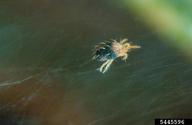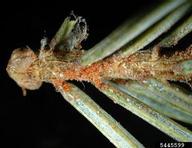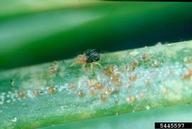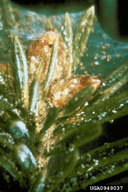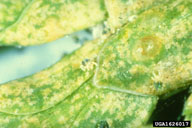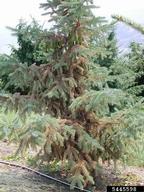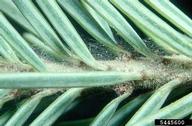Spruce spider mite
Oligonychus ununguis (Jacobi) (Acari: Tetranychidae)
Orientation to pest
Spruce spider mite, Oligonychus ununguis (Jacobi), is a cosmopolitan spider mite of uncertain origin associated with spruce (Picea) and other conifers. All life stages (egg, immature stages, adult) occur together on the host foliage, which is webbed over as a infestation grows. Winter is passed in the egg stage. Multiple generations occur per year. Outbreaks are often induced by the use of pesticides but may occur naturally in dry years. Outbreaks are more common on young trees, on which mites prefer older foliage in the interior of the tree.
Hosts commonly attacked
This mite feeds on Colorado (Picea pungens Engelm.) and white (Picea glauca [Moench] Voss) spruce, Douglas-fir (Pseudotsuga menzeseii Mirb.), thuja (Thuja), jack (Pinus banksiana Lamb.) and some other pines, eastern hemlock (Tsuga canadensis [L.] Carrière), and larch (Larix).
Distribution
Spruce spider mite is found in many countries around the world, and its origin in unknown. Its occurrence on introduced plants in countries lacking native conifers suggests that at least part of this distribution is from invasion, likely due to movement of infested woody nursery stock.
Images of spruce spider mite
| Figure 1. Adult of spruce spider mite, Oligonychus ununguis | Figure 2. Eggs of spruce spider mite | |
| Figure 3. Colony, with webbing, of spruce spider mite | Figure 4. Close up of chlorotic spotting causing by spruce spider mite feeding | Figure 5. Damage on white spruce from spruce spider mite (left) and close up of webbing from mite (right) | |
Important biological control agents related to this pest species
As with most spider mites, control agents are various species of predatory mites (Phytoseiidae), predatory gall midges (Cecidomyiidae, genus Feltiella), and ladybird beetles (Coccinellidae), which vary by region. Destruction of such natural enemies through widespread use of pesticides for control of other forest pests can induce outbreaks of O. ununguis. This occurred in Montana in the 1950s, for example, when DDT was applied over a large area for control of western spruce budworm (Choristoneura occidentalis Freeman). Such problems are most likely in plantations, seed orchards, or Christmas tree farms that are regularly treated for various insect pests.
Web links for information on spruce spider mite
- Fact Sheet | Natural Resources Canada
- BugwoodWiki Article | wiki.bugwood.org
- Christmas Tree Fact Sheet | Pennsylvania State University & PDA
Articles
- Löyttyniemi, K. and K. Heliövaara. 1991. Effect of forest fertilization on the spruce spider mite Oligonychus ununguis (Jacobi) (Acarina, Tetranychidae). Acarologia 32: 139-143.
- Shrewsbury, P. M. and M. R. Hardin. 2003. Evaluation of predatory mite (Acari: Phytoseiidae) releases to suppress spruce spider mites, Oligonychus ununguis (Acari: Tetranychidae), on juniper. Journal of Economic Entomology 96: 1675-1684.
